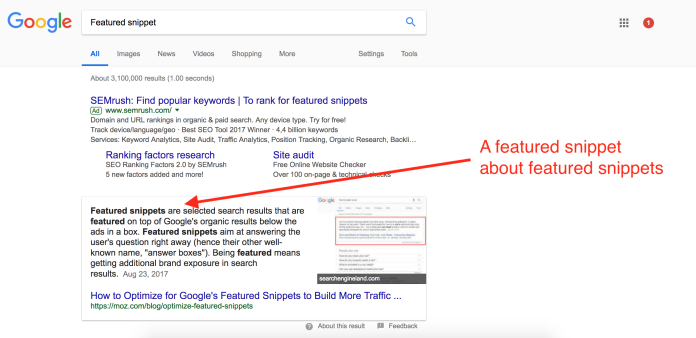Featured snippets are a very powerful online tool for businesses to aim for. SEO professionals and SEO companies alike can attest that a featured snippet is a highly sought-after spot on any search engine result page (SERP). A featured snippet, particularly on Google, can put a website’s content right at the top of a search engine page, even if that website may rank much lower otherwise.
A snippet from a webpage can grab the featured snippet status if Google’s algorithm understands that particular snippet to be the best answer to a question or search that a user has put into the search box.
But how exactly can you work to get your content to appear as a Google-featured snippet? We are going to answer this question below in a few different ways that you, an SEO professional, or a Columbus digital marketing agency can optimize online content to hopefully nab the featured snippet for the search results most relevant to you.
What is a Featured Snippet?
A featured snippet is a sought-after spot for anyone who is handling SEO. At its most basic, a featured snippet is an expanded snippet that appears on a Google SERP. On Google, these snippets usually appear as two to four-sentence-long summaries of a particular webpage that the algorithm has determined to be a good answer to someone’s search input.
Google defines a featured snippet as “special boxes where the format of a regular search result is reversed, showing the descriptive snippet first.” Google also notes that their featured snippets come from web search listings and that their automated systems are what determine if a page would ultimately make a good, featured snippet.
Five Ways to Optimize Your Content to Appear as a Google Featured Snippet
So, how exactly can you or an SEO company optimize your content so that it will appear as a Google-featured snippet?
Here are five ways to optimize your content to shoot for that coveted featured snippet spot.
Get started with some research to pick your keywords.
You cannot begin optimizing your content with no roadmap. So, first, start by performing some solid SEO keyword research. You may already have an idea of some relevant keywords for your website, but it never hurts to do additional research when you are looking to optimize content.
For example, say you are a record store local to the Columbus, Ohio area. Chances are, simply optimizing your website and content for basic words like “record”, “Columbus”, and “music” will not do too much for you, especially as you look to get a featured snippet.
But by utilizing keyword tools like Google’s own Keyword Planner and others like Ahrefs or SEMrush, you will get a fuller idea of the most relevant individual and combo keywords you can use to optimize your content and better answer search queries people are looking up.
Choose a featured snippet format that suits your content.
When it comes to Google’s featured snippets, there are three common types of formats you will come across. These include:
Bulleted or numbered lists
Paragraphs
Tables
Paragraph form featured snippets are pretty common, especially when online users are searching for questions that begin with “what” and “why.” List formatted snippets will usually be associated with “how” queries.
To help you determine what format you want to use, consider the content on your page and what it is doing. Are you providing a list of information for site visitors to read over or are you trying to answer a question? This will help determine what format you should be writing your content in.
Use general language in your optimized content.
Aiming for more general language in your content that is being optimized to be picked up as a featured snippet can go a long way to standing out as a helpful answer to search queries. When users are looking for answers to certain questions, they will often be expecting to get more general information as opposed to an answer that centers on a brand or business.
Try to look at the featured snippet from the point of view of someone searching on Google. Someone searching for an answer to a question will most likely want a brief or specific answer that gives them the information they need.
But that snippet of information that has been optimized to grab the featured snippet spot will also entice them to click through to view the longer piece of content.
Make sure your content meets Google’s featured snippets policies.
There’s no point in optimizing your content if it doesn’t meet Google’s policies for featured snippets. These policies are helpfully laid out on Google’s page about how featured snippets are chosen, noting that they have features in place to ensure that content in featured snippets does not violate their policies.
Content that violates these policies include:
Deceptive practices
Hateful content
Dangerous content
Violence and gore
Vulgar language and profanity
The above is not an exhaustive list, so be sure to see Google’s content policies in full for more information. If you are unsure if your content may violate Google’s policies, you can check it against their listed policies or work with a Columbus content writing agency that can take a closer look at your online content.
Split Reef is a Columbus digital marketing agency that offers a full suite of digital marketing and digital development services. With offices located in Jacksonville, Florida, and Columbus, Ohio, their services include everything from mobile app development, organic SEO,
and responsive web design to social media marketing and SEO copywriting. They have become a trusted, cutting-edge Columbus SEO company with a dedicated team of technical experts that handle work for a wide variety of clients across industries. They make use of industry-leading tools and strategies by keeping up to date with the ever-evolving technology available to them. Connect with them over the phone or online to learn more.



